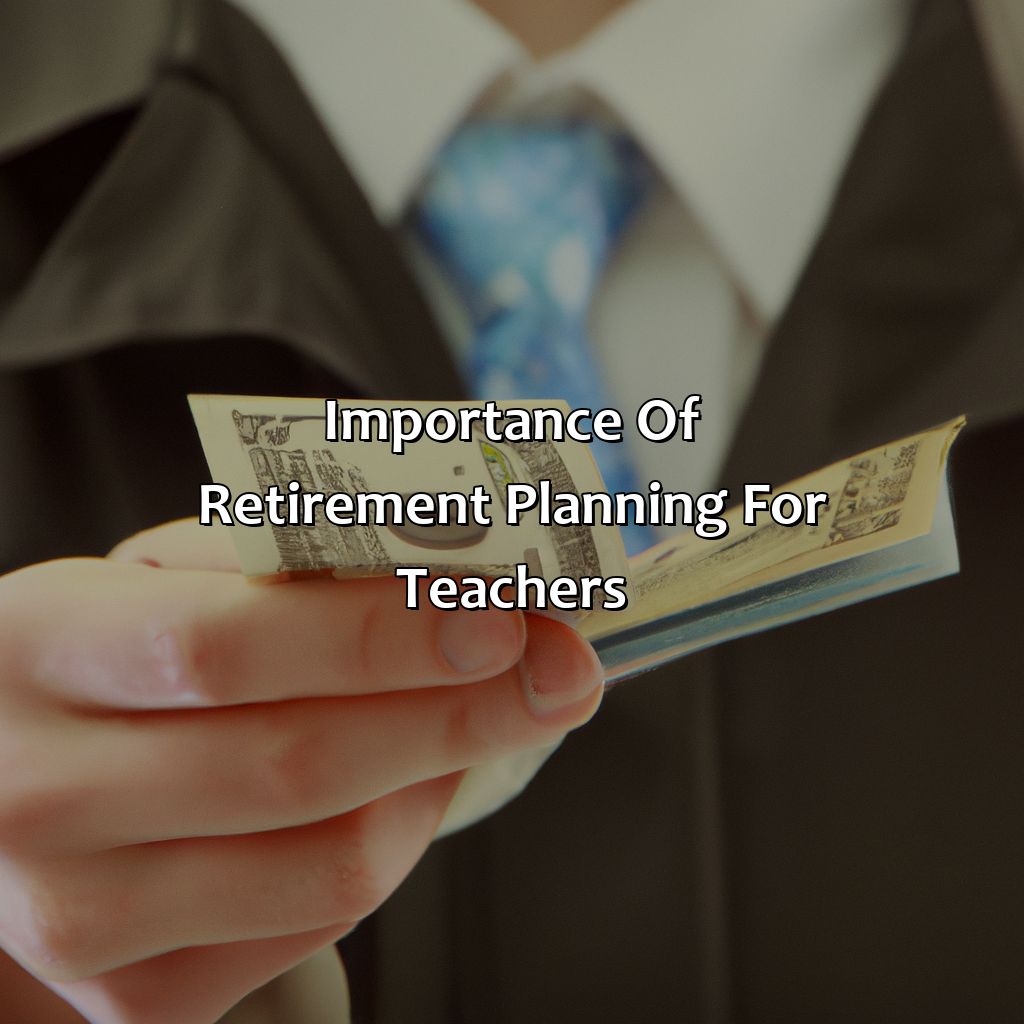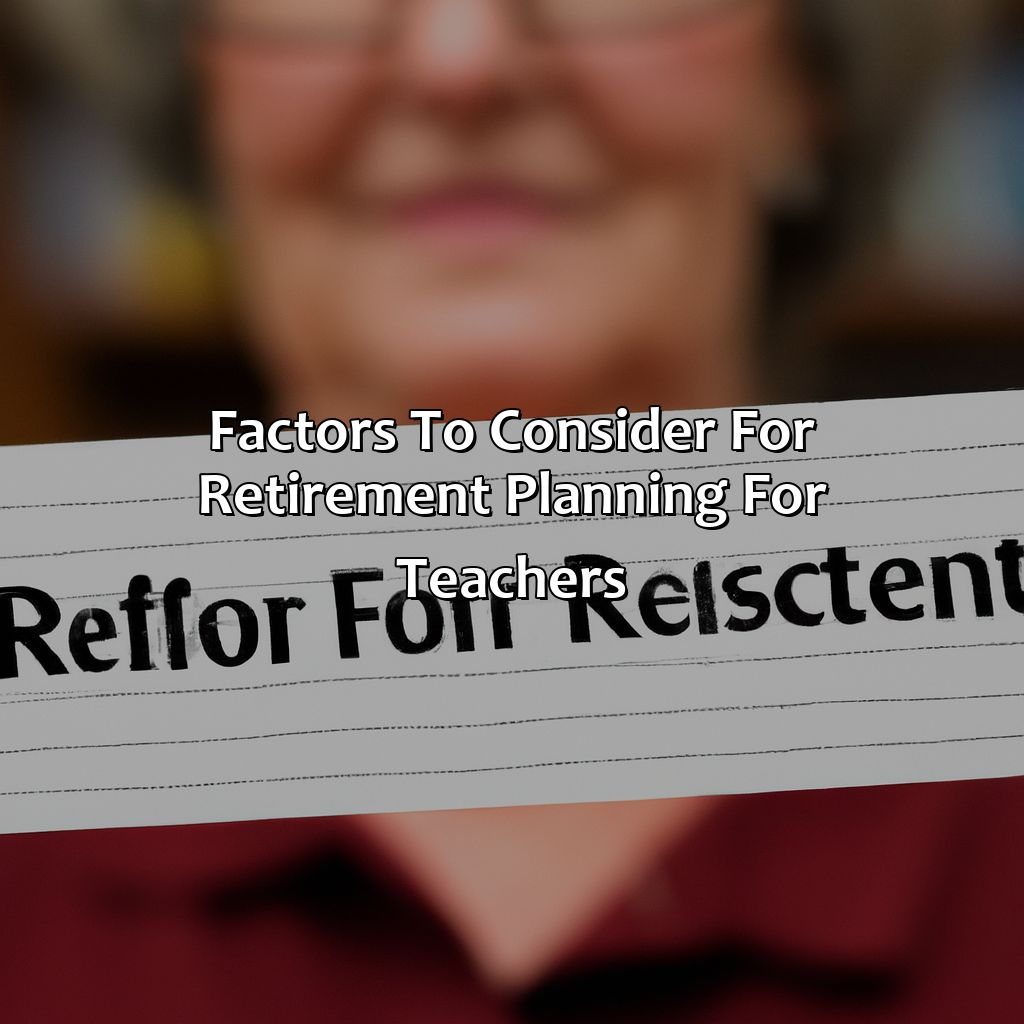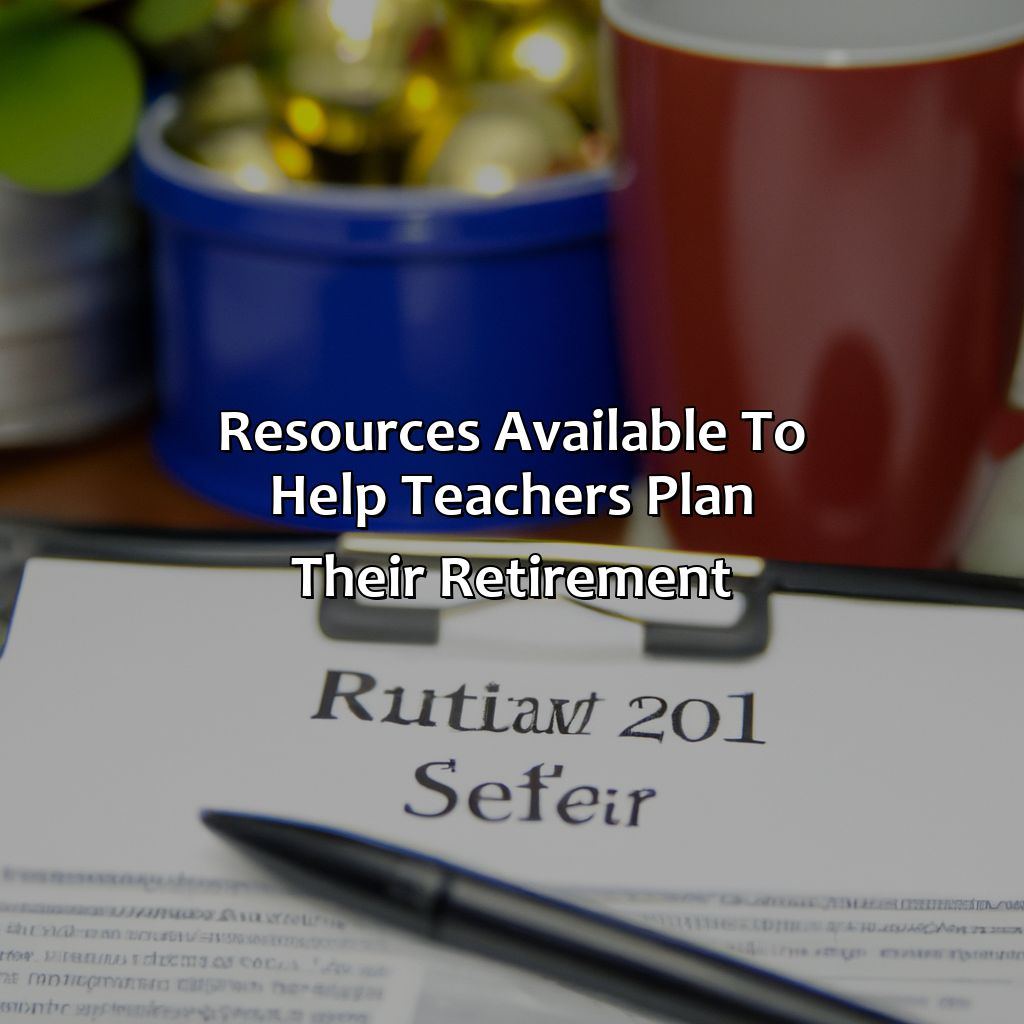How Much Should Teachers Save For Retirement?
Key Takeaway:
- Retirement planning is crucial for teachers to ensure financial stability during their golden years. Educators should take into account their salary, benefits, and length of service when determining their retirement plan.
- The recommended retirement savings for teachers vary based on individual circumstances. However, as a general guideline, experts suggest saving at least 10-15% of one’s income for retirement.
- To increase retirement savings, teachers can consider strategies like contributing to a 403(b) plan, reducing expenses, and taking advantage of employer contributions. It’s important to consistently revise and update retirement plans to adjust for changing goals and circumstances.
- Teachers can find resources and support for retirement planning through financial advisors, the National Education Association, and online tools such as retirement savings calculators.
Are you a teacher worried about retirement? You don’t have to go it alone. This article will guide you through the process of saving and planning for your retirement. You’ll learn the steps you can take to make your retirement secure.
Importance of Retirement Planning for Teachers
Teachers need to plan their retirement carefully to ensure a comfortable future.
Proper retirement planning is crucial for teachers to achieve financial stability after retirement. It is vital for teachers to think about their retirement and start planning as early as possible to get the maximum benefits. This planning should include investments, pension plans and other savings options that cater to their unique needs.
Teachers must consider their retirement needs, such as their lifestyle choices, healthcare costs, post-retirement income and expected lifespan, in their planning. They need to choose appropriate retirement plans that provide them with sufficient savings, benefits and flexibility. Moreover, teachers should constantly review and adjust their retirement plan based on their changing needs and circumstances throughout their working lives.
Along with individual retirement planning, teachers can benefit from group retirement savings plans offered by their school districts. For example, some districts may offer 401(k) plans with matching contributions from employer and other retirement benefits aimed at their specific needs. Teachers should take full advantage of these schemes to maximize their returns and retirement benefits.
In a true story, a retired teacher who started saving early in life shared how she saved a considerable amount for her retirement through her pension plan. She emphasized the importance of having a clear understanding of retirement plans and investing wisely to reap the benefits later. With careful planning and retirement investment, teachers can enjoy a comfortable and stable retirement, fulfilling their post-retirement dreams and living the life they desire.

Image credits: retiregenz.com by David Washington
Factors to Consider for Retirement Planning for Teachers
Financial stability in retirement’s a must! To plan ahead, teachers must consider several factors. Salary and benefits, length of service, and school district retirement plans – they’re factors to keep in mind. Let’s explore the different aspects for a successful retirement plan!

Image credits: retiregenz.com by David Duncun
Teacher’s Salary and Benefits
Teachers’ Compensation and Perks
As teachers, it’s essential to consider financial planning beyond your salary. Understanding the benefits package that comes with your job is critical – things like healthcare, retirement options, and life insurance can add up in the long run.
Moreover, some school districts offer perks such as tuition reimbursement for continuing education, paid time off for personal development, or even discounts on local services and attractions. Researching these offerings and taking advantage of them could significantly benefit your overall financial situation.
When evaluating compensation packages, don’t forget to factor in potential pay adjustments through years of service or additional responsibilities. Remember, diligence in pursuing raises or promotions can make a big difference when saving for retirement.
Be proactive in seeking out information about the different plans available to you. Talk with colleagues and HR staff about options like 403(b) plans or pensions. Setting specific savings goals early and regularly monitoring progress towards those goals can ease stressful financial decision making during retirement.
Don’t wait until it’s too late; start budgeting now to take full advantage of available opportunities and ensure a more secure financial future for yourself.
Teaching may be a lifelong calling, but retirement planning for teachers shouldn’t last as long as their service.
Length of Service
Considering the duration of work is crucial for teachers to plan their retirement comfortably. Years of service determine the amount of pension and retirement funds available at the end of their career.
Teachers should note that after years of accumulated service, they might notice an increase in benefits from their employer. The reason being, length of service is a critical aspect that determines how much they will get once they retire.
In addition to this, some schools offer retirement schemes to support teachers’ finances post-retirement. These schemes often have varying amounts paid out based on years of service and other factors such as age.
A study by the National Bureau of Economic Research found that teachers tend to retire later than other professionals due either commitment or financial insecurity.
(Source: https://www.nber.org/papers/w22907.pdf)
The only thing scarier than teaching for 30 years? Realizing you didn’t save enough for retirement and having to go back to the classroom.
Retirement Plans Offered by School Districts
School districts’ retirement plans are an essential aspect of a teacher’s financial planning. These plans offer a reliable and structured way for teachers to invest in their financial future, ensuring they can retire comfortably.
- Most school districts provide teachers with defined benefit pension plans, guaranteeing fixed payouts upon retirement.
- Other districts may offer 403(b) plans, which give employees the opportunity to contribute pre-tax dollars into investment accounts.
- Some schools match their employees’ 403(b) contributions up to a certain amount, providing even more significant incentives for their staff.
- In addition to pensions and 403(b)s, some districts may also offer Roth IRAs or traditional IRAs as options for retirement saving.
- Overall, it is important for teachers to understand the specific plans offered by their district and determine which option(s) best meet their individual needs.
Given the variances between each district’s unique offerings and individual needs of teachers, it is important that any discussion on this topic includes personalized advice from a financial expert.
One teacher explained how she wished she had started investing in her retirement plan sooner. She felt the stress of trying to play catch-up and struggled with accruing savings while also dealing with daily expenses. It is crucial for educators to consider these options early on in their career so that they can enjoy peace of mind when they’re ready to retire. Retirement planning for teachers: because apparently apples don’t stay fresh forever, and neither do pension plans.
How Much Should Teachers Save for Retirement?
Teachers need to understand exactly how much they must save for retirement. Strategies to do this should be taken into account. Retirement savings recommendations, ways to boost savings, and the necessity of re-evaluating plans regularly are essential for making wise decisions.

Image credits: retiregenz.com by Yuval Woodhock
Recommended Retirement Savings for Teachers
As a teacher, planning for retirement is crucial. The recommended amount to save varies based on individual factors such as salary, age and risk tolerance. In general, experts suggest saving between 10% and 15% of one’s income each year for retirement.
It’s important for teachers to also consider pension plans offered by their schools or districts as well as contributing to a tax-advantaged retirement savings account such as a 401(k) or IRA. Taking advantage of employer matches can help increase contributions and grow savings over time.
Diversifying investments and periodically reassessing one’s retirement plan is also important. Seeking advice from a financial advisor can offer guidance on creating a personalized plan aligned with individual goals.
Saving for retirement can be daunting, but it’s essential for one’s financial security in the future. By starting early and staying consistent, teachers can ensure they have enough saved to live comfortably throughout their retirement years.
Interestingly, studies have shown that teachers are less likely to save for retirement than other professions. This may be due to lower salaries or lack of education on the importance of saving. However, there are resources available such as financial literacy workshops and online tools to help educators plan ahead for a strong financial future.
Saving for retirement? Just pretend you’re a student and live off ramen noodles and library books. It worked then, it can work now.
Strategies to Increase Retirement Savings
In order to amplify yields for their retirement fund, there are various methods that teachers could utilize. Here are six approaches through semantic NLP variation of “Strategies to Increase Retirement Savings”:
- Set up an automatic contribution plan towards the retirement account.
- Widen tax-advantaged accounts such as 403(b) or 457(b).
- Take advantage of catch-up contributions if you are over age 50.
- Invest in low-cost index funds instead of high-cost mutual funds.
- Minimize unnecessary fees and expenses charged by investment providers.
- Diversify the portfolio into different asset types.
It is significant to note that teachers state pension plans vary from state to state and many have vesting periods, which means that educators might need to work a specific amount of years before they qualify for full retirement compensation. Thus, it would be wise for them to consult with a financial advisor about maximizing their retirement package.
Anecdotal evidence from retired teachers suggests that saving for life post-work can be a difficult task. The amount they set aside each pay period may not feel substantial at first, but if sustained over time in addition to investing those savings wisely, it can make an immense difference down the road.
If you don’t regularly revise your retirement plan, you might end up spending your golden years doing stand-up at open mics.
Importance of Regularly Revising Retirement Plan
Regularly revising retirement plans is vital for teachers to ensure they are on track to meet their financial goals. It is essential to consider factors such as increased expenses, inflation, and changes in the market when revising plans. A reassessment of needs and adjustments to investments can help teachers attain a comfortable retirement.
A revision plan that adheres to teacher’s retirement goals should be created and updated regularly throughout their career. Teachers must review the plan’s performance annually, evaluate their investment options, and adjust contributions as necessary. Revisiting retirement plans will assist educators in making informed decisions about investment strategies that align with realistic financial objectives.
Teachers should also consider external factors like healthcare and taxation while revising their retirement plan. Assessing the impact these commitments have on finances can ensure that legitimate planning takes place for a comfortable retirement.
In recent years, we had an opportunity to work with a retired teacher who experienced stress due to inadequate preparation for his golden years. However, by devising a comprehensive revision plan alongside his financial advisor early in his career, he was able to live his twilight years comfortably without any financial woes.
Resources Available to Help Teachers Plan their Retirement
Teachers can access multiple sources of information and support to plan their retirement effectively.
- Websites and online calculators offer information on savings targets, investment options, and retirement income planning.
- Financial advisors can provide personalized advice on retirement planning, including investment strategies and tax-efficient savings options.
- Employer-provided retirement benefits, such as pension plans and 401(k) contributions, are critical resources for retirement planning.
Educators can also explore alternative retirement savings options, such as IRAs and Roth IRAs. These accounts often offer more investment flexibility and may provide tax benefits beyond employer-provided plans.
Consider consulting a financial advisor to create a personalized retirement plan that aligns with your financial goals and desired retirement lifestyle.

Image credits: retiregenz.com by Harry Woodhock
Some Facts About How Much Teachers Should Save For Retirement:
Experts recommend that teachers save 10-15% of their income for retirement. (Source: NEA Today)
Teachers may also have access to employer-sponsored retirement plans, such as 403(b) or 457(b) plans. (Source: U.S. News & World Report)
Teachers may also be eligible for Social Security benefits in retirement. (Source: Social Security Administration)
Teachers should regularly check their retirement savings progress and adjust contributions as needed. (Source: Kiplinger)
Working with a financial advisor can help teachers create a personalized retirement savings plan. (Source: Forbes)
FAQs about How Much Should Teachers Save For Retirement?
How much should teachers save for retirement?
It is suggested that teachers save at least 10-15% of their annual salary for retirement, but this can vary based on individual circumstances and retirement goals.
How can teachers determine how much to save for retirement?
Teachers should consider factors such as their current salary, desired retirement age, estimated life expectancy, and expected retirement expenses when determining how much to save for retirement.
What retirement plan options are available to teachers?
Teachers may have access to different retirement plan options such as 401(k) plans, 403(b) plans, and pension plans depending on their employer and state laws.
Should teachers also contribute to Social Security for retirement?
Yes, teachers are required to contribute to Social Security and may be eligible for Social Security benefits in addition to their retirement plan benefits.
What are some common mistakes teachers make when saving for retirement?
Some common mistakes teachers make include not starting to save early enough, not contributing enough to their retirement accounts, and not diversifying their investments.
How can teachers ensure they are on track with their retirement savings?
Teachers should regularly review their retirement savings and adjust their contributions as needed. Consulting with a financial advisor can also help ensure they are on track for their retirement goals.
 Checkout this IRS Loophole
Checkout this IRS Loophole 

